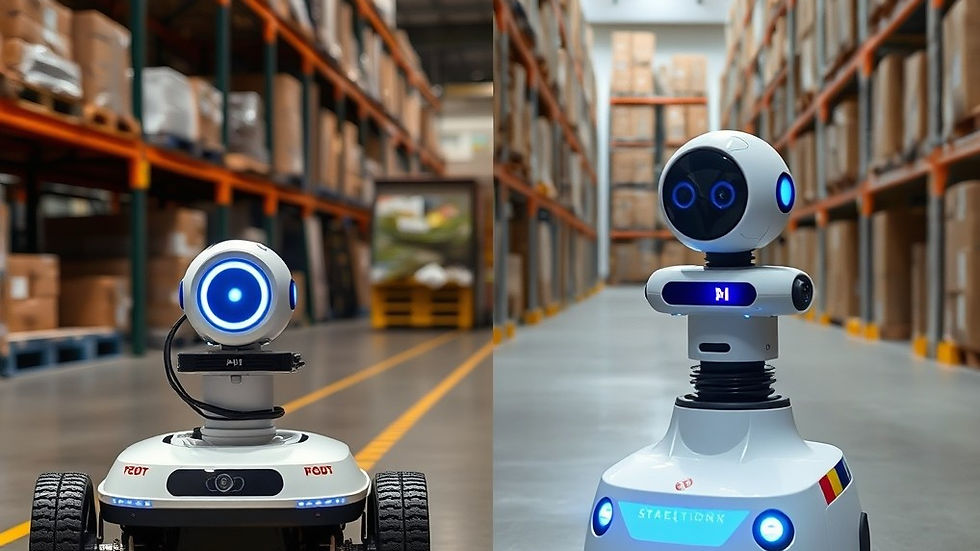Breaking Barriers: How AI-Driven Robotics Are Redefining Automation in 2025
- Marini Shen
- Apr 10
- 3 min read
Updated: Jun 3
In 2025, AI is no longer just a tool—it’s the core engine driving the next generation of robotics. Across industries, businesses are no longer asking “Should we automate?” but “How far can AI take us?”
Welcome to an era where robots don’t just follow instructions—they learn, adapt, and make real-time decisions. Let’s explore how AI-powered robotics are breaking traditional barriers and unlocking new levels of intelligence in automation.
The Evolution of Robotics with AI
Robotics has come a long way since the early days. The landscape has shifted dramatically. Today, AI is at the heart of this transformation. AI-driven robots are not just tools; they are capable of thinking and evolving. We will look at several key areas where this change is evident.
From Rule-Based to Real-Time Intelligence
In the past, industrial robots were predictable and rigid. They were pre-programmed, repetitive, and functioned only within strictly defined environments. However, today's AI-driven robots operate differently.
With the integration of machine learning, sensor fusion, and computer vision, robots can now:
Navigate complex environments using SLAM algorithms.
Detect and respond to unforeseen changes instantly (like rerouting if an obstacle appears).
Make real-time decisions independently of human input.
In a logistics hub, for example, a robot doesn’t merely follow fixed paths. It dynamically selects the best route based on factors such as traffic, delivery priority, or even predictive maintenance data.

Learning, Adapting, Improving
Machine learning models embedded within robotic systems enable continuous improvement. These robots do not require a reset; they evolve through experience.
Imagine a warehouse robot that:
Learns the most frequently used travel routes.
Predicts peak traffic hours within the facility.
Adjusts its battery usage based on historical task data.
The outcome? A robot that becomes smarter the more it works—not only quicker, but also more strategic.

Seamless Integration with Complex Systems
Another significant advancement in 2025 is interoperability. AI-powered robotics seamlessly integrate with various systems, such as:
Warehouse Management Systems (WMS)
Enterprise Resource Planning (ERP) platforms
IoT-enabled factory ecosystems
This capability allows a fleet of mixed-brand robots to operate under one unified control platform. Take Movel AI’s Fleet Management System (FMS), for example—robots can communicate with each other, adjust tasks based on upstream data, and react to events across operations.

Real-World Impact of AI Robotics
Let's examine the numbers and impact:
AI-powered robots in manufacturing have boosted productivity by 30–50%.
Logistics companies report up to 40% improvement in order accuracy.
In hospitality, AI bots have cut customer wait times by over 60%.
This isn’t future-speak. It’s a reality today, scaling globally.

Future Trends in AI and Robotics
Looking ahead, we can expect several exciting developments:
Autonomous multi-agent collaboration, where robots coordinate like teams.
Predictive decision-making across fleets, with robots anticipating demand before it spikes.
Enhanced human-robot interaction in public spaces—from hospitals to hotels to airports.
The key takeaway is clear: AI has become the bridge between human goals and robotic execution.

Challenges and Considerations
While the advancements in AI robotics are impressive, there are challenges. Ensuring security, privacy, and ethical considerations is paramount. Businesses must create standards and guidelines to manage these complex interactions.
Additionally, workforce training is essential. As robots take on more tasks, workers need skills to manage and work alongside these machines. This integration will determine the success of AI in various sectors.
Final Thoughts
As automation grows more intelligent, the gap between human logic and machine action is closing rapidly. At Movel AI, our mission is to build systems that do more than automate—they understand, adapt, and improve.
If you’re looking to future-proof your operations, now is the time to explore what AI-driven robotics can do for you.
👉 Contact us to discover how Movel AI can help your business break barriers with smarter robotics.
%20(1).jpg)


